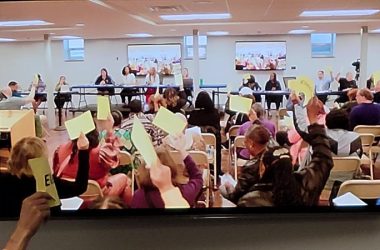The Village of Flossmoor is leaning toward pursuing a regional detention approach to addressing flooding issues related to the Flossmoor Road Viaduct at Sterling Avenue, which would be the cheaper of two options and is expected to provide 10-year flood protection.
While no official vote was taken on the matter, all but one member of the Flossmoor village board came to a consensus during a meeting held Feb. 1 to pursue regional detention near Heather Hill Elementary School rather than a more expensive north conveyance route.
The latter plan would have provided 100-year flood protection for both the viaduct and the village’s downtown civic center but could create more construction concerns, as well as the perception of pushing the problem down the road to another neighborhood, according to a report from the project’s design engineer, Baxter & Woodman.
But Trustee James Mitros said he would prefer to see Flossmoor planning for bigger weather events than the detention plan allows.
“We know we have bigger issues than a 10-year rain event,” Mitros said. “In my lifetime, I’ve seen that civic center flood, and that bothers me. … That’s kind of where my heart lies, in terms of this project.”
“Significant flooding,” up to 7 feet in depth, has left the viaduct under the Metra/CN railroad tracks “completely impassable not only to regular motorists but emergency vehicles,” according to Matt Moffitt of Baxter & Woodman.
“Flooding occurs, on average, once a year or more,” he said.
The flooding in Flossmoor has occurred for decades but has increased in recent years along with more plentiful rainfall, according to a report by Public Works Director John Brunke. Baxter & Woodman completed a study of both the viaduct and an oft-flooded area in the Heather Hill neighborhood near Berry Lane.
The north conveyance route preferred by Mitros would provide 100-year protection at the viaduct and the civic center, as well as 10-year protection for Berry Lane, Moffitt said. But it is also more expensive, estimated to cost $8.69 million versus $7.24 million for regional detention.
Opting for the north conveyance plan also would reduce funding opportunities, Moffitt said. The village has a roughly $1.5 million commitment from the Army Corps of Engineers. Flossmoor also has been awarded roughly $700,000 from the Metropolitan Water Reclamation District and Illinois Environmental Protection Agency. But Mayor Paul Braun noted MWRD is not interested in the north conveyance plan, so going that route could cost Flossmoor funding. Braun said he also did not like the idea of pushing water to another neighborhood.
The north conveyance approach also would involve heavy construction to Flossmoor Road, Moffitt said.
“There’s a good chance Flossmoor Road would have to shut down for the duration of the construction,” Moffitt said. “At best, it would have to shut down to one lane.”
The north conveyance would discharge into Butterfield Creek. While Moffitt said it is unlikely to have much of a practical impact there, it would likely be perceived poorly by landowners in the floodplain.
“No matter how well we engineer this and how well we prove it … the next time there’s a flood event that happens along that creek … they’re going to point blame and I’d guess a good possibility of lawsuits,” Moffitt said.
But Mitros told the engineer he is not a lawyer and that is simply “conjecture.” Moffitt’s report noted the village could try to mitigate downstream concerns by adding a detention area at the Flossmoor Golf Club, but that would come at a higher cost.
Moffitt noted 10-year flood protection is what most towns seek, as it is both the industry standard and what is required by the Illinois Department of Transportation. Flossmoor, in particular, has had only one storm in the last five years that exceeded that 10-year threshold, according to Moffitt’s presentation.
“Generally, storms larger than this are seen as too large to handle,” he said. “Some try to go above and beyond, but I would say the most frequent and common is to get to that 10-year mark.”
The regional detention alternative would provide 10-year protection for the viaduct, civic center and Berry Lane. It would be less expensive and alleviate concerns about shifting the problem to another area. But during larger storms the viaduct could prove to be impassable, and there would be a risk of flooding at the civic center. With this plan, the detention facility could be increased to provide 25-year protection for the civic center, but again at an extra cost, estimated to be roughly $1 million.
“That doesn’t make sense to me,” Mitros said. “We could solve the whole thing for an extra $450,000.”
But most trustees said they want to pursue the regional detention plan, in part because it leaves more of a recently approved $10 million bond sale — designed to be split between flooding and road concerns — for road work.
“I’m leaning fairly strongly toward the regional detention,” Trustee Perry Hoag said. “It’s not a perfect solution. I don’t think we’re going to have a perfect solution.”
Trustee Diane Williams added, “My heart is with Jim, and my brain is with Perry on this issue. I’m supportive of the regional option.”
Williams noted part of that is a desire to help fund the work with outside money and in turn leave more money for road repair. Trustee Joni Bradley-Scott similarly said it is not a perfect plan for flooding, and she would like to consider the 25-year option for the civic center, but the village needs to consider all projects with the money at its disposal.
“The 10-year (plan) doesn’t check all of the boxes, but it cumulatively puts us in a better position than we’re in now,” she said.
Trustee Brian Driscoll added, “I personally think to get the most out of our bond money … the regional detention plan, we’re getting a lot.”
The village has been discussing the project with Flossmoor School District 161 and Homewood-Flossmoor Park District staff, as some of the work required would be on property those bodies own. Further discussions with those boards must take place before Flossmoor could move forward with the regional detention plan.
“We’re obviously talking about making some improvements to properties we do not own,” Village Manager Bridget Wachtel said. “We need to be sensitive to that.”



